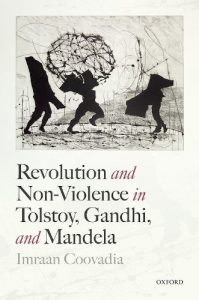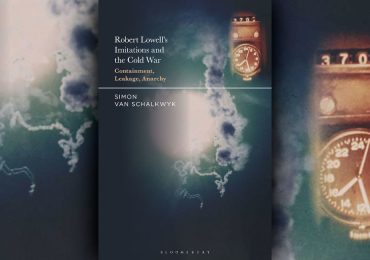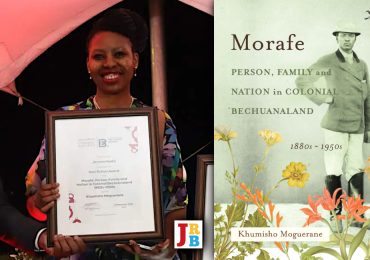The JRB presents an excerpt from Imraan Coovadia’s new book Revolution and Non-Violence in Tolstoy, Gandhi, and Mandela.

Revolution and Non-Violence in Tolstoy, Gandhi, and Mandela
Imraan Coovadia
Oxford University Press, 2020
Read the excerpt:
~~~
It is through the figure of the dog that Coetzee most completely addresses mortality. Unlike the sheep on the way to the abattoir, the dog has no knowledge of its own mortality. It is a creature for which one mourns, an occasion to exercise the minimum elements of human mourning. So the young Coetzee’s dog is killed in Boyhood when ‘he eats the ground glass someone has put out for him’.⁶⁰ The boy Coetzee ‘helps to bury Cossack, wrapped in a blanket, in the clay at the bottom of the garden’. Finally, ‘he erects a cross with the name “Cossack” painted on it. He does not want them to have another dog, not if this is how they must die.’
The problem of animal killing converges, for Gandhi and Coetzee, in the destruction of nuisance dogs, one way in which the relationship between violence and non-violence resurfaces in the context of otherwise peaceful everyday life. For Gandhi on the ashram, it involved a rare concession to necessity, one in which he went to considerable pains to minimize: ‘It is our practice to destroy rabid dogs … Healthy dogs have not been destroyed.’⁶¹
Animal life was not in itself sacrosanct. He discussed the issue in Young India in 1926. Gandhi argued that ‘everyone has to act according to his own light. Let no one learn from me the duty of destruction’. It is an unusual, likely unique reflection in which Gandhi’s way of thinking resembles liberal utilitarianism: the ‘religion of ahimsa consists in allowing others the maximum of convenience at the maximum of inconvenience to us, even at the risk of life. Everyone has to determine for himself the amount of inconvenience he is capable of putting up with. No third party can determine it for him.’ Decisions about animal killing are devolved to the individual to calculate his ‘maximum of convenience’, a recognition that, under special circumstances, the life and death of animals must be determined by human calculations rather than by doctrine.
For Coetzee, as for Gandhi, nuisance dogs made it impossible to avoid certain contradictions of ethical life. In Coetzee’s case the well-known conclusion of Disgrace finds his protagonist, David Lurie, helping to kill stray dogs in a humane way, reducing their suffering and disposing of their corpses. The ending to the novel prompted Nadine Gordimer’s objection that dogs were privileged objects of sympathy in Disgrace compared with the black characters.⁶² For some readers the criticism was obtuse, confusing the imaginative work of fiction with political egalitarianism. For others it was a natural question. We do not have to choose one response or the other to recognize that the reading public was polarized by Coetzee’s writing. The division was primarily, although not entirely, on racial grounds. Certainly Gordimer spoke in accord with the view, held by many black South Africans, that animal well-being is more important to many white South Africans than the welfare of their compatriots.⁶³ The drive to reduce suffering and extend the scope of moral concern, on this view, has become entangled with racial privilege.
What points of literary interpretation are at issue between these two strains of humanitarianism? Gordimer, along with many black South Africans, considers Disgrace within a South African frame of reference. In this context the concern for animals is at least provocative. So is the well-known central scene of Disgrace in which a white woman, daughter of the protagonist, is raped by three black men whom she will refuse to hold accountable. Critics who were closer to Coetzee saw the novel in a global context within which his respect for the rights of animals have nothing to do with the colonial weighting of animals and native peoples.⁶⁴ The different visceral reactions testify to the potency of the materials with which the narrative is constructed. The question of whether a local or global frame should be applied in any particular case was, as we have seen, a key concern of Gandhi, Mandela, and Tolstoy, a productive anxiety which contained diverging impulses to universalism and particularism.
In the case of Disgrace, David Attwell rules out any reflection on the scene of Lucy’s rape: ‘none of this discussion [should] have been necessary in the first place, given the obvious revulsion for racialized discourse, and especially for racialized politics, which is intrinsic to most of Coetzee’s oeuvre’.⁶⁵ For Attwell, consideration of a novel’s subject matter, usually the first interest of an ordinary reader, is inherently reductive for a novel’s ‘socially mimetic function’, is its ‘least complex—and, arguably, least interesting—area’. He argues, moreover, that there is no racial content to the rape because ‘the blackness of the black characters is the least significant feature of their representation’. In fact ‘race is bleached out of the episode almost entirely’.⁶⁶ The argument verges on the unsupportable. Rape is an issue notoriously invested by racial fear and fantasy. Indeed Attwell takes the contradictory position that ‘Coetzee is more than aware of the implications of taking on this subject … In a review essay on Daphne Rooke he [Coetzee] refers to the rape of a white woman as “the ne plus ultra of colonial horror-fantasies”. This being so, would it not be a failure of nerve to avoid it?’ This entire defence is required to maintain a strained view of an author whose work is saturated by notes of complicity.
More insightful perspectives on Coetzee’s project can be found in the work of formally attentive critics. Peter McDonald’s comprehensive analysis in ‘Disgrace Effects’ argues that Disgrace is ‘as much about the ethics of reading’ as about the ethics of living.⁶⁷ McDonald acknowledges the potential for provocation—‘Coetzee’s supposed report on white racism indeed appears dangerously uncertain in its implications. Stripped of its challengingly complex rhetoric, Disgrace does, after all, depict at the level of story not just gang rape, but black-on-white assault, burglary, and police incompetence.’ By ‘giving privileged space to the idea of the white as victim, and by using the colonial nightmare topos—the violation of white women—it can also be seen to play up to “white fears”.’ McDonald also considers ways in which a reader’s identity may direct his or her reaction. The novel ‘puts the reader, especially (but not exclusively) the black, gay, or woman reader, in the uneasy, even provocative, position of being obliged to see the story through a disturbingly alien gaze’.
McDonald resolves, or suggests resolving, the issues that he has raised by turning content into form—‘On this sort of reading the rape … would feature not as a sign of the “realities of South African life” … nor as a manifestation of “white fears”. Its justification would lie primarily in its narrative function measured in part by its impact on the novel’s central characters.’⁶⁸ Yet readers respond to content as well as form. First-order reactions to subject matter co-exist with the second-order effects of literary structure.⁶⁹ Even if the rape is kept offstage, it is a powerful element within Coetzee’s storytelling. McDonald’s analysis of the narrative leads more naturally to the idea of literary imagination as a kind of violation. In considering Disgrace, the critic Patrick Hayes recommends ‘a full acknowledgement of the contingent and compromised position from which literature emerges’.⁷⁰ He finds in the novel ‘an unruly current of rogue energy that sustains and drives, but can also override, the ethical’.⁷¹
The ‘unruly current’ in Disgrace, in my view, carries the fears and fantasies of a racially divided society. The role of provocations in such a society is a complex and discomforting one, especially in the telling of stories and jokes, but has been addressed at length in the work of VS Naipaul.⁷² Coetzee’s ‘experiments’ should be given equal consideration. The question of which sensitivities we enforce is also important. The discussions around the rape scene in Disgrace would have been very different if it was a novel written by a German author, five years after the end of the Second World War, in which three Jewish men figured in the rape of a Christian woman.
⁶⁰ Boyhood, p. 50.
⁶¹ CWG 37: 358.
⁶² See Patrick Hayes, JM Coetzee and the Novel Writing and Politics after Beckett (Oxford: Oxford University Press, 2010) for an critical account of Gordimer’s differences with Coetzee: ‘The reason Coetzee is telling such lies about black heroic identity is because of his own “stately fastidiousness”: the “revulsion against all political and revolutionary solutions” that Life & Times expresses is emphatically Coetzee’s “own revulsion” towards a revolutionary identity politics. His own definition of freedom, Gordimer claims, refuses any role for a properly political form of heroism rooted in “the energy of the will”, for Coetzeean freedom is merely “to be ‘out of all the camps at the same time”’(75–6). Hayes continues: ‘Recall that Gordimer coupled her attack on the perceived political untruthfulness of Life & Times of Michael K with an ad hominem attack on Coetzee’s “stately fastidiousness”—his wish, which she deduced from his earlier fiction, “to hold himself clear of events and their daily, grubby, tragic consequences in which, like everyone else in South Africa, he is up to his neck”. I have suggested that this is at best a limited way of reading the text, and at worst one that holds back, in a self-protective gesture, from its most distinctive and challenging effects’ (101–2).
⁶³ On this issue see, by this author, ‘Best Friends and Worst Enemies’, https://lareviewofbooks.org/ article/best-friends-worst-enemies-years-dog-south-africa/ [August 29, 2014]).
⁶⁴ For a discussion of this question of context, see Peter D McDonald, ‘Disgrace Effects’, Interventions 4:3: ‘[There were] relatively innocuous case[s] of restrictive territorialization. Far more damaging were the various readings of it as a “South African novel” of a deeply racialized kind, made by the ANC and other South African commentators’ (323); see also Tlhalo Raditlhalo, ‘Disgrace, Historical Trauma and the Extreme Edge of Civility’, Trauma, Memory, and Narrative in the Contemporary South African Novel, eds Mengel and Borzaga (Netherlands: Rodopi, 2012), pp. 243–64.
⁶⁵ David Attwell, ‘Race In Disgrace’, Interventions 4:3 (2002), p. 332.
⁶⁶ ‘Race in Disgrace’, p. 336.
⁶⁷ ‘Disgrace Effects’, p. 326.
⁶⁸ ‘Disgrace Effects’, p. 327.
⁶⁹ For an alternative but plausible reading, see M van Wyk Smith, ‘Rape and the Foundation of Nations in JM Coetzee’s Disgrace’: ‘It must be equally obvious that Coetzee has made Lucy’s rape as predictably horrendous, sensational, infuriating, racist and yet as platitudinous and archetypically South African as he possibly could, bar actually depicting the event itself in terrifying and provocative detail. Yet the Luries’ responses, albeit very divergent, both turn out to be as far removed from the standard South African reaction to the farm attack and the racialized rape as Coetzee could go, so much so, of course, that while the ANC and similarly inclined readers rejected the novel as racially provocative and as an insulting reiteration of a standard white demonization of blacks, some readers rejected the denouement as preposterous’ (English in Africa 41: 1 [May 2014], p. 15).
⁷⁰ Patrick Hayes, JM Coetzee and the Novel, p. 167.
⁷¹ Patrick Hayes, JM Coetzee and the Novel, p. 177.
⁷² Patrick Hayes offers a sympathetic account of a certain type of provocation on Coetzee’s part which gingerly recognises the possible element of racial conflict in the novels: ‘In a South Africa dominated by powerful political constructions of black identity in heroic struggle, Coetzee’s text tentatively opens out onto other ways of perceiving what a hero might be, and does so in a way that is worthwhile and important’ (103). Hayes argues that the ‘main energies of Foe are therefore devoted to complicating, both in literary and political terms, what we mean by “the foe”. The text won’t let us join together as “friends” to decide the issue instead, it hunts out ways of tripping up our judgement, and in so doing, of keeping divergent political impulses, and divergent sympathies, in a productive tension’ (JM Coetzee and the Novel, p. 128).
~~~
- Imraan Coovadia is an essayist, academic and novelist. His most recent novel is A Spy in Time.
About the book
The dangers of political violence and the possibilities of non-violence were the central themes of three lives which changed the twentieth century—Leo Tolstoy, writer and aristocrat who turned against his class, Mohandas Gandhi, who corresponded with Tolstoy and considered him the most important person of the time, and Nelson Mandela, prisoner and statesman, who read War and Peace on Robben Island and who, despite having led a campaign of sabotage, saw himself as a successor to Gandhi.
Tolstoy, Gandhi, and Mandela tried to create transformed societies to replace the dying forms of colony and empire. They found the inequalities of Russia, India and South Africa intolerable yet they questioned the wisdom of seizing the power of the state, creating new kinds of political organisation and imagination to replace the old promises of revolution. Their views, along with their ways of leading others, are closely connected, from their insistence on working with their own hands and reforming their individual selves to their acceptance of death. On three continents, in a century of mass mobilisation and conflict, they promoted strains of nationalism devoid of antagonism, prepared to take part in a general peace.
Looking at Tolstoy, Gandhi, and Mandela in sequence, taking into account their letters and conversations as well as the institutions they created or subverted, placing at the centre their treatment of the primal fantasy of political violence, this volume reveals a vital radical tradition which stands outside the conventional categories of twentieth-century history and politics.






One thought on “‘The idea of literary imagination as a kind of violation’—Imraan Coovadia considers JM Coetzee’s Disgrace, excerpted from his new book Revolution and Non-Violence in Tolstoy, Gandhi, and Mandela”